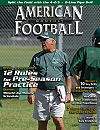Article CategoriesAFM Magazine
|
Speed Report: Teaching Drills Properly – the KEY to Playing Fastby: Dale BaskettFootball Speed Specialist © More from this issue We all like drills. The correct speed drills are the KEY for the best player development. When we arrange drills weekly and monthly for a speed development program, we must have a plan. That is, a plan that puts drills in an arranged order. This is a must for progressive skill development. Without it, you are working in vain. All learning skills and especially running movement skills must be taught in a progressive order. This is because the skill applications for running are constantly active at all times. The limb activity of running varies in terms of body velocity and limb frequency but, the control of limb synchronicity must not breakdown as speeds vary. Unfortunately, they will breakdown whenever frequency changes occur. This is a cold fact which leads us to the teaching process of progression training.
|
|
|||||||
| HOME |
MAGAZINE |
SUBSCRIBE | ONLINE COLUMNISTS | COACHING VIDEOS |
Copyright 2026, AmericanFootballMonthly.com
All Rights Reserved





